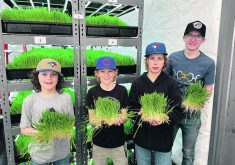Rural revitalization in this part of east-central Alberta takes a village — and a community, a school and a group effort
MEDICINE HAT — Along the rolling Neutral Hills of east-central Alberta near the Saskatchewan border, a group of communities are bucking the trend of declining rural towns.
Kirriemuir, Altario and Compeer, collectively known as KAC, and the nearby communities of Consort and Veteran, are pushing back against pressures that see populations shrink in many hamlets, villages and towns.
The communities are in the heart of Special Area No. 4, a region directly controlled by the province due to dissolution of municipal districts during the 1930s dust bowl era.
Read Also

Volatile temperatures expected for this winter
DTN is forecasting a lot of temperature variability in the Canadian Prairies this winter. Precipitation should be close to average.
The peak population was estimated at 30,000 in the three districts of Special Areas 2, 3 and 4 in the mid-1920s, but half the people left within a decade due to drought and the Great Depression.
Since the 2000s, the region’s population has largely stabilized. Oil and gas activity, farming and ranching provide the backbone of the local economy.
In many rural Alberta communities, the population skid often starts with loss of the railway, followed by the school, then the banks, stores and service clubs.
But starting in 2017, the KAC communities decided to halt the decline, according to local business owner Natasha Pospisil.
“You have to think so far out of the box. It’s about changing not only how you address the problem but changing how you see the future,” she said.
“The future is going to look different. You want to create something that is going to look different than it did in the past. You can’t try to recreate the past. You have to be a visionary and create a new future.”
Pospisil said for the KAC communities, that meant starting with schools, and with Altario School in particular.
It had gone through six principals in as many years before current administrator Kevin Van Lagan took the helm.
“We had gotten to the point where there wasn’t a whole lot left, aside from community spirit, some good people,” said Van Lagan. “The communities were just getting smaller and smaller and fewer and fewer children and families, which meant smaller and smaller schools.”
To reverse that trend, the KAC communities embraced their agricultural traditions by introducing a program to the school.
“We have what we call a student-led farm,” said Van Lagan. “Students are involved in the day-to-day operations of a small farm here at the school where we raise a variety of animals — cows, chickens, turkeys, pigs, sheep, bees.”
The school added a modular unit in which students produce hydroponic leafy greens and a second unit where they research indoor barley fodder production.
That shift reversed the trend of declining enrolment. The school is now attracting more families to the region.
“We’re having a sense of identity and life in the community,” said Van Lagan.
In 2017, the community developed a vision board that defined goals to better develop services.
Many of those goals have been met, said Pospisil, including establishment of a community pre-school.
“You’re planting all these seeds and you are starting to see the flowers grow. You are starting to see the progress,” she said.
But it takes effort to harvest those successes and maintain them, she added.
“You have to empower the young people to maintain the momentum. You have to know even if you’re spearheading something or behind something, that your whole intention is to be able to hand that torch off, so it goes far beyond you into the next generation.”
Schools are a natural starting point for any community that tries to stem population decline, said Van Lagan.
“That’s our building block, is the school. When you can work out from there, when you have strong schools, there are reasons for people to move to rural areas.”
Pospisil also said the communities surrounding KAC are supporting growth, from the baseball academy in Veteran to the hospital in Provost.
But when it comes to basic services, Consort is the backbone with its three banking institutions, grocery store and newspaper with print shop.
Dave Bruha, editor of the Consort Enterprise, said dedicated people who live in the communities that run along Highway 12 are trying to make the region a better place.
The family-owned newspaper has been a community mainstay since 1912 and once ran under the slogan, “A Paper With A Mission and Without a Muzzle.”
“They put their money where their mouth is,” said Bruha of the communities in Special Area No. 4. “They invest in business. They invest in different opportunities. They care about their communities and growing them.”
There’s a different feel outside the region, he added. Though the nearby town of Hardisty is a hub for the oil industry, most businesses that operate there are based in Calgary.
“I think it has more to do with the size of the community. If you are 1,000 people or under, people seem to be more invested in it. You get a little bit larger, and the attitude is someone else will do it or only big business can help us,” said Bruha.
And while some communities try to be something they’re not, Van Lagan said those in the KAC group are comfortable with who they are.
“With what we’ve done in our community, we’re not just OK with it. We’re proud of it and we promote it,” he said. “We want people to know about our community, about our school and the way we’re doing things and we want to share it with any other community that wants to do something similar.”
















